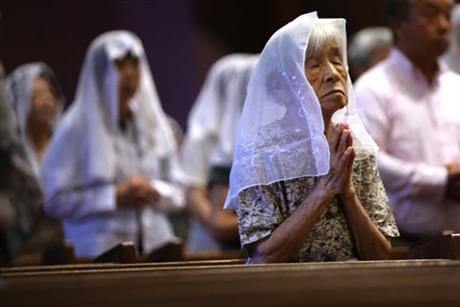
Photos by EUGENE HOSHIKO; text by MIKI TODA
Just after dawn Sunday, the faithful filed into Urakami Cathedral in the Japanese city of Nagasaki for a Mass tinged with sadness.
Seventy years ago, a U.S.-dropped atomic bomb detonated about 500 meters (550 yards) from the church, killing two priests who were hearing confessions and about 30 other people inside. The more than 70,000 who died in Nagasaki in the Aug. 9, 1945, bombing included 8,500 of the cathedral’s 12,000 parishioners, decimating Japan’s largest Christian community.
The church has been rebuilt from the rubble, and a sizeable crowd entered the wooden pews for the early morning Mass on Sunday. The women, many of them elderly, wore translucent white veils bordered with intricate lacework as they clasped their hands together in prayer.
Later, on a sultry summer evening, the community held what has become an annual event: an outdoor procession with the scarred wooden head of a Virgin Mary statue that stood in the main altar at the time of the blast.
The bust, which was in three pieces, was put back together by woodwork artisan Isao Nishimura, who also built a new altar for it in a dedicated chapel next to the cathedral.
The artisan has his own story of survival and guilt.
On the morning of the bombing, his mother had scolded 12-year-old Nishimura for not going to confession at church. The boy rushed to Urakami Cathedral; on the way, he passed some friends playing in a river and told them he would join them after quickly going to church.
Once there, he found a long line of people waiting their turn. Nishimura, a neighborhood bully, cut in front of the line, glaring back at the little children, who gave him a dissatisfied look.
By 11:02 a.m., when the bomb went off, he was at home with his mother and younger brother. He remembers a flash of light and being thrown to the ground. Part of a wall collapsed on his left arm.
Every year, attending a memorial ceremony at his elementary school, Nishimura said he hears the voices of his classmates who didn’t make it.
“I wish they were here with me now to see how Japan has become a peaceful place,” he said.
___



